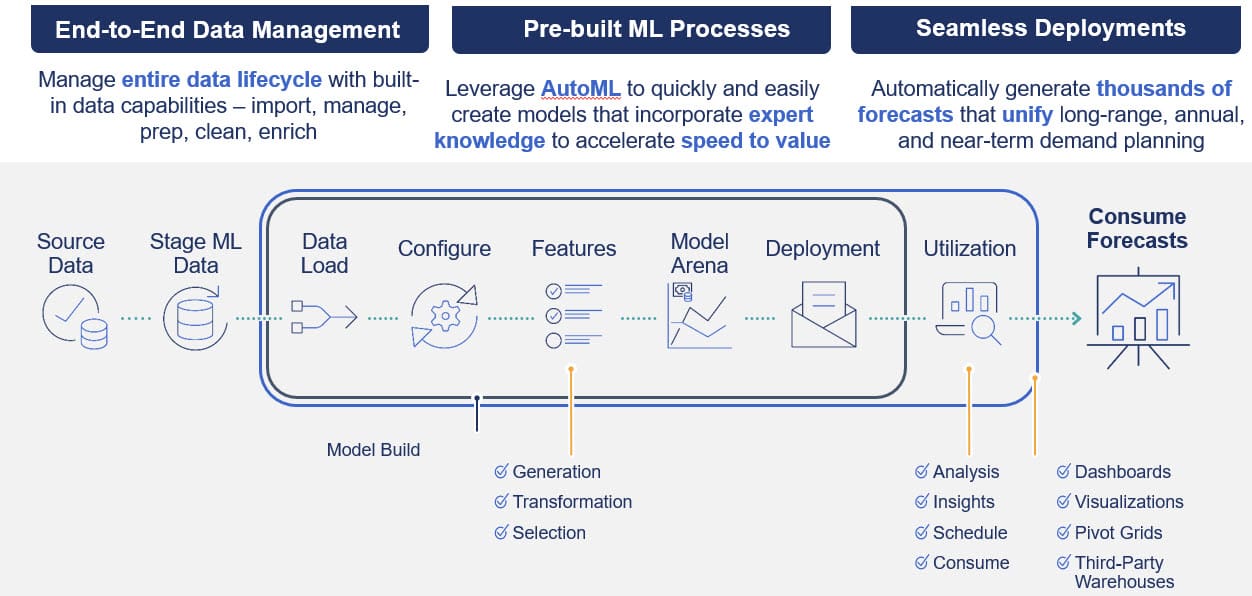As economic volatility keeps rising in frequency and magnitude, Financial Planning & Analysis (FP&A) teams are facing unprecedented pressure. Traditional quarterly or annual budgeting is becoming obsolete, unable to keep pace with rapid changes – rendering static budgets irrelevant. Additionally, exponential growth in data sources and volume requires extensive data transfer, reconciliation and consolidation processes before insights can inform budgets, forecasts or plans. But business planners are in luck. Why? Several use cases of AI in enterprise Finance enable faster data processing, increased forecast accuracy and deeper insights.
Rapidly becoming essential for all enterprises, AI ultimately streamlines processes, unlocks valuable insights and drives strategic decision-making. Soon, AI will be embedded across all enterprise Finance processes. This blog post therefore explores 3 use cases of AI in enterprise Finance, setting the stage for a deeper dive into OneStream’s innovative Sensible Machine Learning solution.
3 Use Cases of AI in Enterprise Finance
Incorporating AI into FP&A is fundamentally reshaping how organizations forecast, budget and make strategic decisions. To show why, let’s explore 3 transformative use cases of AI in enterprise Finance:
1. Predictive Forecasting
Predictive forecasting is a cornerstone of FP&A, enabling organizations to anticipate future financial performance and make informed decisions. AI-driven predictive analytics offers a paradigm shift in forecasting accuracy and reliability. How? By leveraging advanced algorithms to analyze historical data and market trends, identify patterns, and accurately predict future financial outcomes. These predictive models provide valuable insights into cash flow management, revenue projections and expenditure planning.
As a result, Finance professionals are empowered to allocate resources efficiently and optimize financial performance.
2. Automated Forecasting and Planning
Traditionally, forecasting and planning processes have been time-consuming and labor-intensive tasks for FP&A teams. But not anymore. AI automation streamlines these processes by automating routine tasks, optimizing resource allocation, and improving the accuracy and agility of forecasting and planning activities. With purpose-built AI solutions, Finance can automate mundane financial processes (e.g., data entry, forecast creation and reconciliation). And that leaves more time for value-added activities.
By integrating AI-driven automation tools into workflows, enterprises can thus accelerate decision-making processes, improve data accuracy and achieve cost savings.
3. Financial Performance Analysis
Financial performance analysis is a critical function within FP&A. Why? Such analysis enables organizations to gain deeper insights into the drivers impacting business operations and profitability. Through embedded AI, such analysis becomes even more insightful and actionable by uncovering hidden patterns and relationships within financial, operational and external data.
Traditional analysis methods, on the other hand, may struggle to identify subtle correlations or complex interactions among the various factors influencing financial performance. But AI algorithms excel at processing large volumes of data and detecting nonlinear relationships that may not be immediately apparent to human analysts.
By analyzing diverse data sources (e.g., financial statements, operational metrics, market trends and macroeconomic factors), AI reveals nuanced insights into the drivers shaping financial performance. Finance professionals can now use these insights to steer the business and stay ahead of the competition.
As Finance continues to embrace AI, a practical and sensible ML approach – one that balances automation with transparency and human insight – has become increasingly important. Effective planning is, after all, critical for businesses to remain competitive and adapt to changing market conditions.
At OneStream, we call this Sensible ML.
Introducing Sensible ML
OneStream’s Sensible ML (see Figure 1) – which is purpose-built for FP&A – is a paradigm shift in leveraging AI for Finance professionals. By seamlessly unifying AI within an enterprise Finance platform, Sensible ML creates thousands of forecasts and insights previously impossible with manual processes.

Figure 1: Sensible ML Process Flow
Purpose-Built AI for FP&A in a Unified Platform
By integrating AI, Finance teams can seamlessly leverage AI capabilities without having separate tools, systems or teams. No longer are the days of having data scientists create a forecast without understanding the business value. Also gone are the days the Finance team receives the output with no understanding of where the numbers originated.
Instead, with purpose-built AI for Finance and Operations, business planners are independently creating ML-backed forecasts. And these planners are doing so for the entire ML-forecasting process – from data ingestion and quality to model building, all the way to utilization and consumption. As a result, Finance professionals can now explain their accurate forecasts with confidence and at scale across hundreds or thousands of forecasts.
Sensible ML also incorporates external factors (e.g., weather, macroeconomic factors) to create highly accurate forecasts and utilizes a unique, groundbreaking concept: the Model Arena.
The Model Arena offers tailored precision by automatically selecting the most performant model for each forecasted line item. In contrast, the one-size-fits-all approach applies a single model for all forecasted line items, failing to account for the characteristics of each product-location combination. The Model Arena approach instead produces a much higher level of accuracy by accounting for the nuances of different forecasted products by locations.
Polaris, a global leader in powersports whose products have vastly different characteristics, offers a good example of the power of Sensible ML. Why? With Sensible ML, Polaris can now forecast for specific products and locations with distinct models across the business. Only a unique ML model tailored for Polaris snowmobiles or off-road vehicles can create an accurate sales forecast. In turn, Polaris can optimize for downstream processes (e.g., resource allocation) or maximize the contribution margin.

Sensible ML’s Model Arena automatically selects the most accurate ML model for every product-location combination within differing business units. Ultimately, then, Sensible ML equips Finance professionals with deeper insights into future financial scenarios, enabling better decision-making and strategic planning.
Conclusion
As AI continues to evolve, the impact on enterprise Finance will only further intensify. AI will continue revolutionizing traditional practices and unlocking new opportunities for growth and innovation. From predictive analytics to process automation and risk management, AI empowers enterprises to navigate complex financial challenges with confidence and agility. Finance professionals who use OneStream’s Sensible ML solution can thus unlock the full potential of AI to drive sustainable business success in the digital era.
Learn More
Want to learn more use cases of AI in enterprise Finance for FP&A teams? Stay tuned for additional posts from our Sensible ML blog series, or download our white paper here.
Download the White PaperGet Started With a Personal Demo



